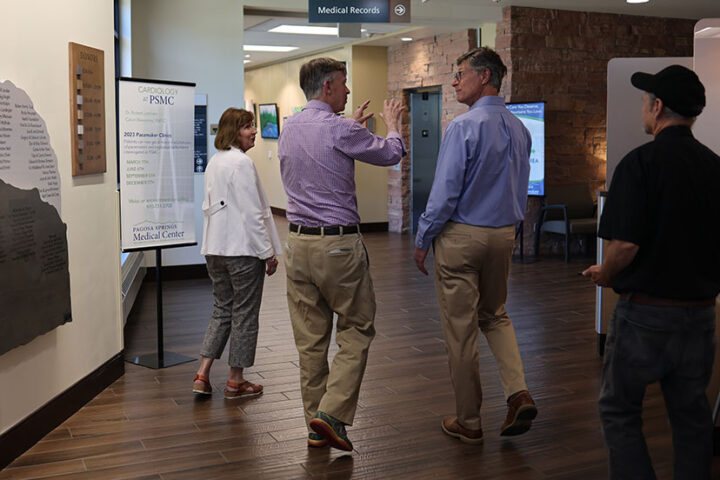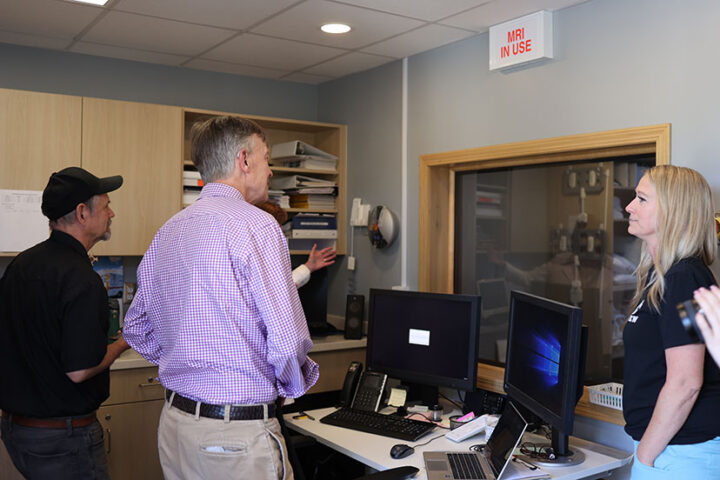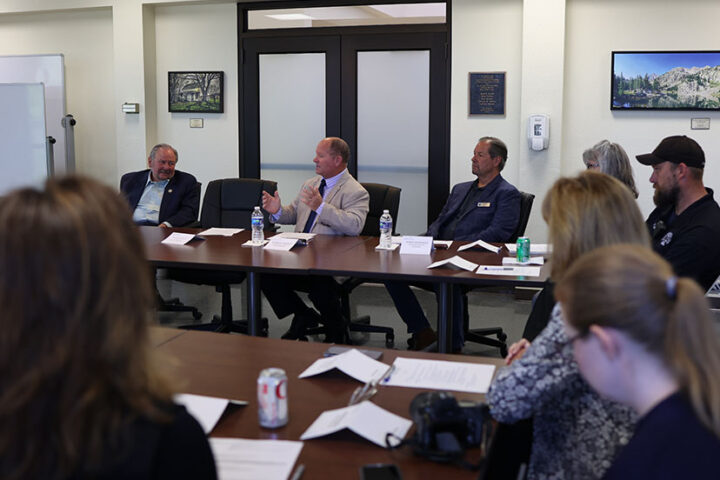Photos by Laura Vanoni.
U.S. Senator John Hickenlooper and a half dozen of his staff arrived at the Pagosa Springs Medical Center right on time, at 1pm Wednesday, and were greeted by Medical Center CEO, Dr. Rhonda Webb, and a few of the hospital staff, including Rhonda Webb’s husband, Dr. Bill Webb, who is employed as an orthopedic surgeon there.
Local media reporters had been invited to cover the visit.
It’s not every day a U.S. Senator visits the Pagosa Springs Medical Center, which opened its doors in 2008 — having been converted from a modest medical clinic into a ‘critical access hospital’. This may have been, in fact, the first time any U.S. Senator has toured the facility, and heard about the struggles of running a hospital in a rural corner of Colorado.
I’m fairly sure this was the first time a U.S. Senator has given out fist-bumps to the staff there.
As we walked through the facility, Dr. Rhonda Webb gave a running commentary, explaining the various services provided in each department and introducing some of the key staff members… and sharing some history about the hospital’s gradual expansion since 2008, in its effort to better serve the community — and also, its effort to remain financially solvent.
More about the financially solvent part, later.
Near the end of the tour, we left the main building and visited the Siemens Magnetic Resonance Imaging (MRI) machine, which is housed in its own small building, inside an enclosed room.
Not many small rural hospitals can boast of having their own MRI, which run about $1.2 million, new. (I don’t recall if the Pagosa MRI unit was purchased new or used?)
The machine was certainly impressive-looking.
The Senator asked if we might be able to take a photo next to the machine. (At least four photographers were on the tour.) But he was told that the machine is sensitive to metal, and he would need to remove his wristwatch and any other metal he was wearing. He quickly concluded, with a chuckle, that the cameras themselves were metal, and so we continued with the tour without entering the MRI room itself.
John Hickenlooper was born in 1952 in Narberth, Pennsylvania, and was raised by his mother from a young age after his father’s death. He attended Wesleyan University, earning a B.A. in English in 1974 and a master’s degree in Geology in 1980, and then moved to Colorado to work as a geologist for Buckhorn Petroleum… only to get laid off in 1986, when Buckhorn was sold.
He and five business partners opened one of the nation’s first brewpubs — Wynkoop Brewing Company — in 1988 after raising startup funds from dozens of friends and family and assisted by a Denver economic development office loan. The Wynkoop was one of the nation’s first brewpubs.
He was elected Mayor of Denver in 2003, thanks in part to a creative advertising campaign. But I suspect he was also helped by a friendly, unassuming personality. and a background as an innovative business owner. In May 2007, Hickenlooper was reelected Mayor with 88% of the vote.
He was elected Governor of Colorado in 2010, and re-elected in 2014.
From Wikipedia:
NPR described Hickenlooper as having a “pro-business centrist profile” and as “known to try to build consensus and compromise on tough issues”, while 5280 magazine called him as “one of those unicorn-rare, truly apolitical politicians”, noting support from business leaders and some Republicans…
…In a YouTube video published to his campaign channel in 2019, Hickenlooper announced that he would run for the United States Senate in 2020. Some preliminary polling data showed him with a substantial lead against incumbent Republican U.S. Senator Cory Gardner. Hickenlooper was already leading the Democratic primary field by a fairly wide margin before he announced. He was quickly endorsed by the Democratic Senatorial Campaign Committee, a move protested by candidates already running before Hickenlooper’s entry.
Hickenlooper defeated incumbent Senator Cory Gardner by 9 percentage points, and took office on January 3, 2021, just three days before the January 6 events at the U.S. Capitol.
Following the walking tour of the Pagosa Springs Medical Center, we gathered in PSMC’s board room (which was once the lobby of the medical clinic, back before 2008). Waiting in the board room were a couple of board members, a County Commissioner, and a number of Upper San Juan Health Services District staff.
The Pagosa Springs Medical Center is a somewhat unusual animal, having evolved as part of the Upper San Juan Health Services District.
The USJHSD is a tax-funded district originally formed as an ambulance service, to deliver patients to the hospital in Durango — something that can be understandably problematic during a winter snowstorm. When I moved to Pagosa in 1993, the USJHSD was operating a small medical clinic called the Mary Fisher Clinic, across the street from the Spa Motel (now the Healing Waters Resort) run by a handful of nurses and doctors and office staff.
30 years later, the taxpayers continue to fund the District to the tune of about $1.5 million a year… but that amount is now a very small portion of the overall Medical Center budget. ($41 million in 2023.)
The board room discussion began with a speech by Republican County Commissioner Warren Brown making an appeal to the Senator for federal funding to expand the Archuleta County airport.
We can probably understand Commissioner Brown’s interest in the Archuleta County airport. We do indeed have emergency flights using the airport, during forest fires and medical emergencies.
But in general, the airport serves local pilots and the owners of private jets. Of all the issues we have in Archuleta County, I truly wonder if an expanded airport is really the most pressing need?
When we have an audience with our U.S. Senator?
On the other hand, the voters of Archuleta County elected Commissioner Brown to represent us, so maybe a majority of our residents agree that a larger airport is at the top of our list.






